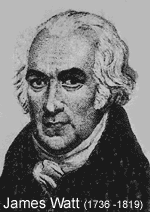Technology improves
Like most inventions, the steam engine was waiting for improvements. Over the next six years, many other improvements had been made to the steam engine. Watt created a double acting engine, in which the steam alternated on the two sides of the pistons. A throttle was also added to control the the power of the engine, and a centrifugal governor to keep the engine from over powering.
Watt designed a compound engine in 1781 and 82, along with many other improvements for easier manufacture and installation. One of these was a steam indicator, which produced a plot of the of the pressure of the cylinder against its volume.
Watt's favorite improvement was the parallel motion/three bar linkage which helped out double engine models by producing the  straight light motion required by the cylinder rod and pump from the connected rocking beam, which end moves in a circular arc. Watt recived this patent in 1784, along with his patent for a steam locomotive.
straight light motion required by the cylinder rod and pump from the connected rocking beam, which end moves in a circular arc. Watt recived this patent in 1784, along with his patent for a steam locomotive.
Since the danger of exploding engines and issues with leaks were very high, Watt was very opposed to the use of high pressure steam from the very beginning. All of his models used low pressure steam.
In 1794 the partnership of Boulton and Watt was established, and exclusivly manufactured and sold steam engines. by 1824 they had produced 1164 engines, which had a total horsepower, a unit of power which Watt is credited for inventing,of 26,000.
Watt's engine ended up being five times more effiecent then the Newcomen engine that he first worked on in 1763. Watt's improvements saved up to 75% of fuel that the original had lost. Watt died with his fortune on August 19, 1819.
